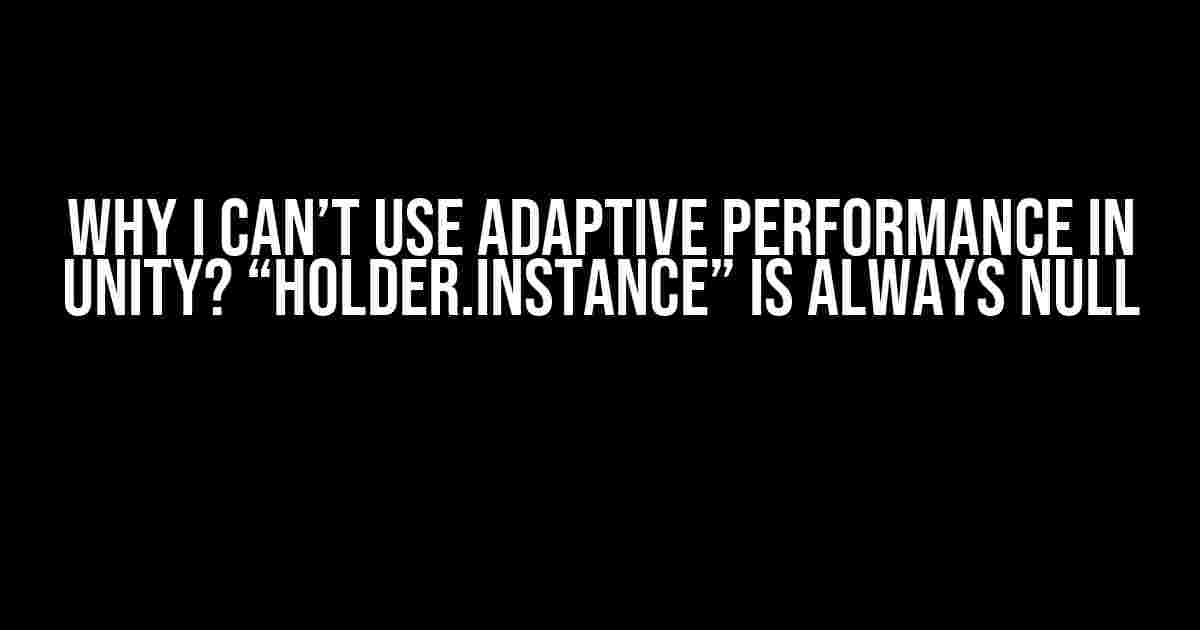If you’re reading this, chances are you’re frustrated because you can’t get Adaptive Performance to work in Unity, and the dreaded “Holder.Instance” is always null error is haunting you.
The Adaptive Performance Promise
Adaptive Performance is a powerful tool in Unity that allows you to optimize your game’s performance on devices with varying hardware capabilities. It’s a game-changer (pun intended) for ensuring a smooth gaming experience across different devices.
But, when you try to implement it, you’re met with the cryptic “Holder.Instance” is always null error. It’s like Unity is taunting you, saying, “Hey, I know you want to make your game faster, but nope, not today!”
The Culprits Behind the Error
Before we dive into the solution, let’s understand why this error occurs in the first place. There are a few common culprits:
- Missing or Incorrectly Configured Adaptive Performance Package: You might have forgotten to install the Adaptive Performance package or configured it incorrectly.
- Insufficient or Incorrectly Set Up Device Profiles: Your device profiles might not be set up correctly or are missing essential information.
- Holder Instance Not Initialized or Not Accessible: The Holder Instance might not be initialized or is not accessible due to scope or namespace issues.
Solving the “Holder.Instance” is Always Null Error
Now that we’ve identified the culprits, let’s get to the solution. Follow these steps to resolve the issue:
Step 1: Verify Adaptive Performance Package Installation
Double-check that you have the Adaptive Performance package installed and configured correctly:
using Unity.AdaptivePerformance;
// Check if the package is installed and configured
if (AdaptivePerformance.Instance == null)
{
Debug.LogError("Adaptive Performance package is not installed or configured correctly.");
return;
}
Step 2: Set Up Device Profiles
Make sure you have device profiles set up correctly. You can do this in the Adaptive Performance window:
// Create a new device profile or edit an existing one
DeviceProfile profile = new DeviceProfile("MyDeviceProfile");
// Set up the profile details
profile.deviceTypeId = DeviceTypeId GENERIC_MOBILE;
profile.performanceLevel = PerformanceLevel.BALANCED;
// Add the profile to the Adaptive Performance instance
AdaptivePerformance.Instance.AddDeviceProfile(profile);
Step 3: Initialize and Access the Holder Instance
Ensure the Holder Instance is initialized and accessible:
// Initialize the Holder Instance
Holder holder = new Holder();
// Make sure the Holder Instance is initialized and accessible
if (holder.Instance == null)
{
Debug.LogError("Holder Instance is not initialized or not accessible.");
return;
}
// Access the Holder Instance
Adapter adapter = holder.Instance.GetAdapter();
Bonus Tips for Troubleshooting
If you’re still encountering issues, try these bonus tips:
- Check the Unity Editor Log: Inspect the Unity Editor log for any error messages related to Adaptive Performance or Holder Instance.
- Verify Script Execution Order: Ensure that the scripts related to Adaptive Performance and Holder Instance are executed in the correct order.
- Disable and Re-enable Adaptive Performance: Try disabling and re-enabling Adaptive Performance to see if it resolves the issue.
Conclusion
Getting stuck with the “Holder.Instance” is always null error can be frustrating, but with these steps, you should be able to resolve the issue and get Adaptive Performance up and running in your Unity project.
Remember to double-check your Adaptive Performance package installation, device profiles, and Holder Instance initialization. If you’re still having trouble, try the bonus tips for troubleshooting.
Happy optimizing, and may the performance be with you!
| Troubleshooting Checklist |
|---|
| ✓ Verified Adaptive Performance package installation |
| ✓ Set up device profiles correctly |
| ✓ Initialized and accessed Holder Instance |
| ✓ Checked Unity Editor log for errors |
| ✓ Verified script execution order |
| ✓ Disabled and re-enabled Adaptive Performance |
By following this guide, you should be able to overcome the “Holder.Instance” is always null error and unlock the power of Adaptive Performance in your Unity project.
Frequently Asked Question
Are you struggling to get adaptive performance working in Unity and always ending up with a null “Holder.Instance”? Don’t worry, we’ve got you covered! Here are some common reasons why you might be facing this issue:
Q1: Is my Adaptive Performance package not installed correctly?
Double-check if you’ve installed the Adaptive Performance package correctly in your Unity project. Make sure you’ve imported the package from the Unity Package Manager, and it’s enabled in your project settings. Also, verify that you’re using a compatible Unity version, as Adaptive Performance requires at least Unity 2019.3.
Q2: Have I missed initializing the Adaptive Performance system?
Ensure that you’ve initialized the Adaptive Performance system correctly. You need to create an instance of the AdaptivePerformanceInitialization class and initialize it in your script. This step is crucial, as it sets up the Adaptive Performance system and allows you to access the Holder.Instance.
Q3: Is my script not running in the correct order?
Check the execution order of your scripts. Make sure that your script that accesses the Holder.Instance is running after the Adaptive Performance initialization script. You can adjust the script execution order in the Unity Editor by going to Edit > Project Settings > Script Execution Order.
Q4: Are there any conflicting scripts or plugins?
If you have other plugins or scripts that interact with the Adaptive Performance system, it might cause conflicts. Try disabling or removing any unnecessary plugins or scripts and see if the issue persists. You can also try resetting the Adaptive Performance package to its default state.
Q5: Have I checked the Unity console for errors?
Lastly, check the Unity console for any error messages related to the Adaptive Performance system. You might find hints about what’s causing the issue, such as incorrectly configured settings or missing dependencies. Take a closer look at the error messages and adjust your code accordingly.
